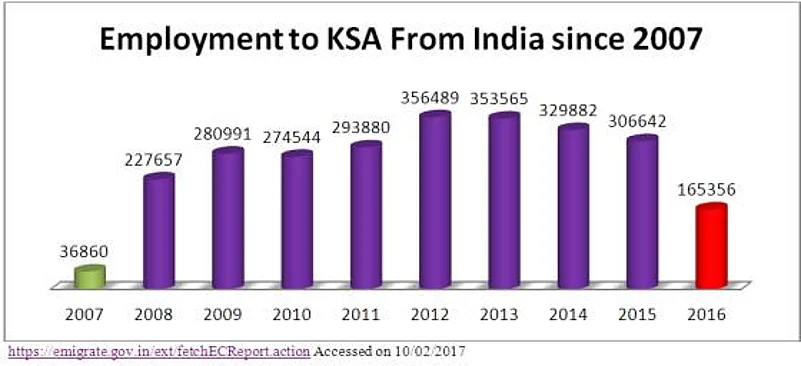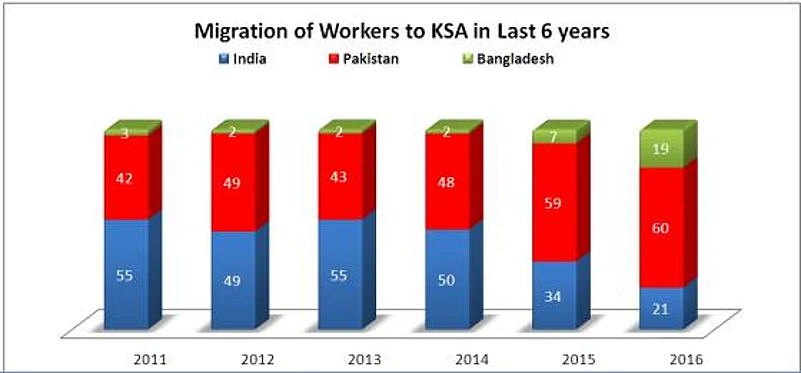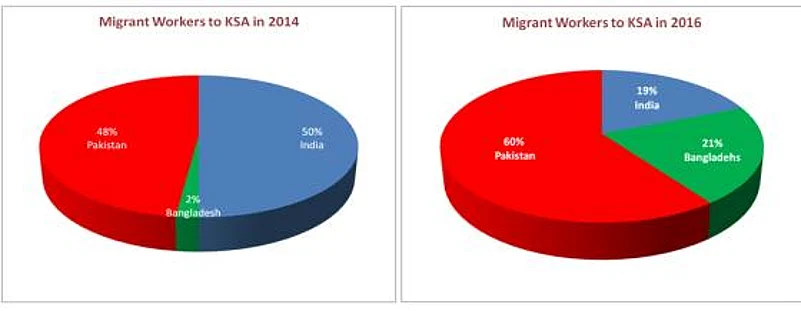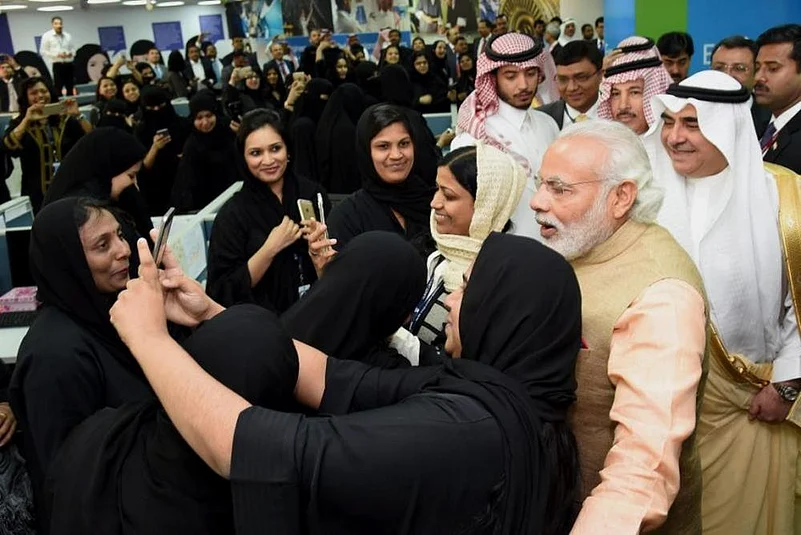The number of Indians who to went to work in Saudi Arabia fell by half in 2016 compared to 2015 and by at least 33% in other Gulf countries – a collateral damage of twin policies implemented by the Union Government.
There are close to 2.96 million Indians living and working in Saudi Arabia– making Indians the largest expatriate community there, forming 30% of the total expatriates of around 10 million. From 2008 to 2015, every year India managed to deploy around 3 lakh workers on an average in Saudi, which was India’s 4th largest trade partner after China, United States, and UAE in 2014–15. It was also our largest supplier of crude oil. Of the seven million Indians who live and work in the oil-rich Gulf nations, around 40% are based in Saudi Arabia and 30% in the UAE.
Advertisement
After 2007, India witnessed the same pace of growth in its overseas migrants’ employment in all other Gulf countries. In the last five years (excluding 2016), around 7.50 lakh Indian workers went to Gulf countries on an employment visa every year. Out of them approximately 3.25 lakh arrived in Saudi Arabia alone.

But in 2016, there has been a dramatic fall in the number of workers who migrated to Gulf countries, especially Saudi Arabia, as compared to the previous year. In total, India could not send 2,51,388 migrant workers to GCC countries in 2016 in comparison with 2015.

The biggest drop in numbers was in Saudi Arabia – close to one and half lakh in just one year.
Advertisement

Causes of Decline in India’s Share of Gulf Migrants’ Employment
The decline was triggered mainly due to two factors: Minimum Referral Wages and the tortuous eMigrate procedure which was designed and developed for the benefit of Indian migrant workers.
eMigrate:
In May 2015, the Centre introduced a unique computerized system called “e-Migrate” to regulate overseas employment, especially to protect lesser educated blue collar workers against possible exploitation. The new system brought various stockholders -- Indian Missions, Foreign Employers, Emigrants and Recruiting Agents on a single platform. It made compulsory for the entire foreign employers to fill up a registration application which is then vetted by the respective Indian mission. Any foreign employer can raise the demand for Indian blue collar workers and seek a permit to recruit Indians only through this system.
This project has not worked in the favour of Indian workers, as Gulf-based employers, not known to be ‘tech-savvy’, have switched over to hiring laborers from Bangladesh and Pakistan. The government's intention to protect interests of Indian workers cannot be disputed but the bureaucratic procedures were bound to defeat the purpose. The bureaucracy, while preparing this system, did not realize that Gulf employers would not take so take the pain to hire Indian workers when they are available on lesser wages in other countries without any such troublesome procedures.
In the initial stage of its launch, the eMigrate online system was a sloth. It could only clear around 8000 passports per month when under the previous system, the ministry was able to clear up to 40,000 passports a month. And in just few months more than 1 lakh passports had piled up at the 10 Protector of Emigrants (POEs) offices in the country, and due to this delay, thousands of visas expired. This was a huge loss for the employers, because they spend thousands of Riyal and Dirhams to obtain the visa in their country. So, the delay in passport clearance, technical faults in the eMigrate system and expiration of visas annoyed the foreign employers.
Advertisement
Minimum Referral Wages (MRW):
New Delhi made a big decision in recent years by bringing a new guideline for Foreign Employers, urging a higher pay for millions of Indian workers in countries falling under the category of “emigration check required” (ECR).
India, in this way, coerced the Gulf countries to raise the wages of its workers in a drive to earn more billions of dollars in fresh income. For instance, in Saudi Arabia, the Indian embassy lifted the recommended minimum salary to 1,700 riyals from 1,200 Riyals in the matter of a month. In the UAE, the minimum wage for some category of Indian blue-collar workers rose to 1,500 dirham from 1,200 dirham.
Advertisement
It was anticipated at the time that because of India’s role as a top labor supplier to the region, salary hikes could boost India’s economy by earning more remittance. In last few years, India received around $70 billion every year as remittance from its workers around the world, in which the Gulf nations accounted for 52%.
Among other origin countries that send the workers to the Gulf region, India’s referral wages are the highest as cited by International Labor Organization (ILO) in a study named ‘MINIMUM REFERRAL WAGES FOR INTERNATIONAL MIGRANT WORKERS FROM INDIA: AN ASSESSMENT’ (S.K. Sasikumar and Seeta Sharma, September 2016).
Advertisement
Therefore, from day one, this regulation was challenged, criticized and had met bitter resistance by the recruiting agents and foreign employers in all six destination GCC countries. Ironically, two of the countries at that time had threatened to reduce their Indian workforces and hire more, lower-paid workers from Bangladesh, Pakistan and Nepal instead.
Who benefited?
India lost a large chunk of Gulf employments, and Pakistan, Bangladesh and some other countries managed to cash in.
Let’s take the specific case of Saudi Arabia, which is facing a severe downfall in Indian migrant workers. Was this decline reflected in statistical reports of other countries that send blue collar workers to the Gulf region?
Advertisement
In recent years, news reports stated that due the low oil prices, political instability in the region, ISIS and Saudi’s war with Yemeni Houthis, the economy of the Gulf countries, especially Saudi economy is crumbling. Has that affected the number of migrant workers going into the Gulf workforce in general and Saudi Arabia in particular?
The leading English-language daily from Jeddah, Saudi Gazette,reported on November 28, 2016 that according to the General Authority for Statistics (GAS), there has been a 12.17% increase in the number of expatriates till the third quarter survey for the year in question. The GAS survey further showed that the number of expatriates in the Kingdom reached 11.6 million by mid-2016. In 2015 there were only 10.2 million expats in the Kingdom.
Advertisement
This report clearly indicates that the inflow of migrant workers into Saudi workforce was never interrupted. But where do these new migrant workers come from?
The answer lies in Bangladesh and Pakistan’s websites dedicated to overseas employment’s regulations and statistics.
Migration Inflow from Pakistan and Bangladesh into Saudi Arabia |
Year
Pakistan
Bangladesh
2011
2,22,247
15,039
2012
3,58,560
21,232
2013
2,70,502
12,654
2014
3,12,489
10,657
2015
5,22,750
58,270
2016
4,62,598
1,43,913
Accessed on 08/02/17
The figures indicate a sharp increase in the number of migrant workers from both the countries going into Saudi workforce in the year of 2015 and 2016.
Advertisement
Till 2014, (the year around which India introduced two new regulations for Indian migrant workers), Pakistan and Bangladesh were sending around 3 lakh and around 10 thousand workers respectively to the Saudi Arabia. All of a sudden in 2015-16 though, Pakistan registered a sharp rise to 5 lakh and Bangladesh witnessed an increase from 60,000 in 2015 to 1.4 lakh in 2016.

The share of Bangladesh in Saudi migrant workforce was constant at around 2 percent for many years until 2014. However, it rose unexpectedly up to 7 and 19 percent respectively in 2015 and 2016. As for as Pakistan’s share, it was always less than that of India but, in 2015 and 2016 Pakistan overtook India and unpredictably hit a 60 percent figure from a previous average of 45 percent per year.
Advertisement
The biggest gainer is Bangladesh, as it was sending only 2 percent workers to Saudi Arabia till 2014. But in two years they have achieved close to a ten-fold increase, and deployed 19 percent workers in Saudi Arabia.

This is a massive financial loss to the Indian economy with the beneficiaries being neighbors Pakistan and Bangladesh. It looks like a clear ‘surgical strike’ on India’s remittance that contributes 4 percent to its GDP.
The Ministry of External Affairs says that according to the World Bank’s statistics, in recent years India received USD 70 billion in remittance from Indians around the world. It is the highest amount of remittance in the world received by any country, and it is almost three times the total FDI coming into the India. So, we can easily understand the value and significance of this USD 70 billion remittance in India’s economy. Out of this USD 70 billion remittance, around 52 per cent came from Gulf expatriates, and among these Gulf countries, Saudi Arabia stands second with approximately 30 percent share followed by UAE with 38 percent share. If we have lost 50 percent of two recent year’s probable employments from KSA in particular, and 35 percent of two recent year’s probable employments from all Gulf nations in general alongside the steep slump in oil prices, it means we have already headed to face a heavy loss in our overall remittance in the financial years of 2015-2016 and 2016-2017.
Advertisement
Intensity of losses
Due to this sudden decline in India’s migrant workers to the Gulf region, the loss that has been inflicted on Indian workers, their families, and on the Indian economy overall, is huge. But, unfortunately nobody from the government side has taken notice of it. Even in the recently held 14th Pravasi Bhartiya Diwas ceremony on January 9, 2017 in Bengaluru, the issue did not even merit a mention.
In 2016, we were short of 2,51,388 jobs in comparison with 2015 as far as the Gulf region is concerned. Let us assume, hypothetically, that if these jobs were given to Indian workers, then what would be its positive impact on their life, their families and India’s economy?
Advertisement
It is an open secret that each Indian worker manages to send back home around Rs 20,000 per month from the Gulf countries. We know quite well that many of them send more than this amount but I have carefully chosen twenty thousand to make my point flawless and put forth a stronger argument. If we multiply this amount with all the jobs that we lost last year (251388 × 20000 = 502,77,60,000), the amount would be more than 500 crore per month, and would total to Rs 6000 crore annually.
These workers, who could not manage to go abroad, now became liabilities of the government of India which had to feed them with subsidized food and provide them jobs at home. India is already facing huge deficits in jobs’ opportunities. According to the fifth annual employment-unemployment survey at an all-India level, about 77 per cent of the households in India were reported to be having no regular wage/salaried person. In a report on September 29, 2016, the Indian Express stated that in 2015-16, India’s unemployment rate was the highest since 2010. This figure itself rings an alarm bell for the BJP-led NDA government at the Centre, which has taken a series of steps such as ‘Make in India’ to create jobs in the country with a very fascinating slogan of “Be a job creator, not a job seeker”.
Advertisement
Most Affected States
Business Standard reported on January 19, 2017, that under the government's eMigrate system, more blue collar workers travelled to ECR countries in 2016 from Uttar Pradesh and Bihar than any other states in India. Their numbers are in the table below:
Top Ten Indian States with Most Emigrants going to ECR countries in 2016 |
State
Number
Uttar Pradesh
1,43,737
Bihar
7,6384
West Bengal
5,3348
Tamil Nadu
42,541
Rajasthan
35,172
Punjab
31,861
Andhra Pradesh
2,7005
Kerala
2,5166
Telangana
2,5079
Orissa
1,2320
https://emigrate.gov.in/ext/fetchECReport.action?StrFileFormat=.pdf Accessed on 11/02/2017
The newspaper also quoted Protector General of Emigrants (PGE) M.C. Luther as saying that shares of Uttar Pradesh and Bihar in overall Indian migrant workers in ECR countries in 2016 are 30 and 15 percent respectively, leaving behind Tamil Nadu and Kerala with only 7 and 6 per cent respectively.
Advertisement
Uttar Pradesh has been solely on top of the list of Indian states with most number of migrants to Gulf countries since 2009 till date. Kerala topped the list only in 2008. As per my study, though UP and Bihar have managed to deploy the maximum number of migrants in compression with other states in 2016, the two states also have suffered the most in terms of decline in their share of blue collar workers.
Way Forward
Here, I would like to point out some uneasy areas which the government can think of for improving the whole emigration clearance system of blue collar workers for the Gulf workforce that has lot of potentials to boost India’s economy by providing bundle of overseas jobs in the Gulf region primarily in Saudi Arabia.
Advertisement
1) Government should scrap the provision of employer’s registration on emigrate system and should bring back the previous procedure of emigration clearance of workers for deployment in GCC countries, that was in practice before 2015.
2) On Minimum Referral Wages, I would suggest that government should give some room for negotiation to the main stakeholders to reach a common ground.
The author is pursuing an M.Phil at Jamia Millia Islamia, New Delhi



















